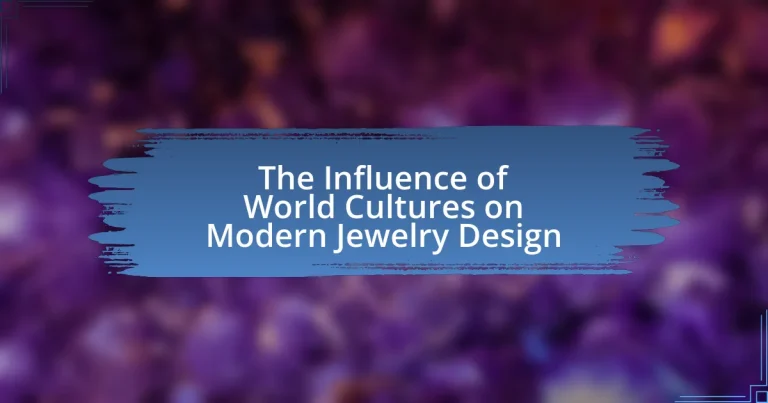The article examines the significant influence of world cultures on modern jewelry design, highlighting how diverse aesthetics, materials, and techniques shape contemporary creations. It explores the contributions of various cultures, including Native American, Japanese, African, and Indian, emphasizing the integration of traditional symbols and craftsmanship in modern pieces. Key topics include the importance of cultural diversity, the role of globalization, and the impact of sustainability in jewelry design. Additionally, the article addresses the challenges faced by Indigenous designers and the emerging trends that reflect a fusion of cultural heritage and modern aesthetics.

What is the Influence of World Cultures on Modern Jewelry Design?
World cultures significantly influence modern jewelry design by introducing diverse aesthetics, materials, and techniques. For instance, the use of intricate patterns and symbolism in Native American jewelry reflects cultural heritage and storytelling, while Japanese craftsmanship emphasizes minimalism and natural forms, as seen in the art of Kintsugi. Additionally, African jewelry often incorporates vibrant colors and beads, representing social status and community identity. These cultural elements not only enrich the design process but also create a global dialogue in contemporary jewelry, allowing artisans to blend traditional practices with modern trends. This fusion results in unique pieces that celebrate cultural diversity and heritage, demonstrating the ongoing impact of world cultures on the evolution of jewelry design.
How do different cultures contribute to contemporary jewelry aesthetics?
Different cultures significantly contribute to contemporary jewelry aesthetics by infusing unique symbols, materials, and techniques into design practices. For instance, African jewelry often incorporates vibrant colors and intricate beadwork, reflecting cultural heritage and storytelling traditions. Similarly, Japanese aesthetics emphasize minimalism and natural forms, as seen in the use of materials like wood and silk, which convey a deep connection to nature. Furthermore, Indian jewelry showcases elaborate craftsmanship with the use of gemstones and intricate metalwork, representing cultural rituals and status. These diverse influences not only enrich the visual language of contemporary jewelry but also promote cross-cultural dialogue and appreciation in the global market.
What specific cultural symbols are commonly integrated into modern jewelry?
Common cultural symbols integrated into modern jewelry include the lotus flower, which represents purity and enlightenment in various Eastern traditions, and the hamsa hand, symbolizing protection and good fortune in Middle Eastern cultures. Additionally, Celtic knots, representing eternity and interconnectedness, are frequently used in Western jewelry designs. These symbols are often chosen for their deep meanings and cultural significance, reflecting the wearer’s identity or beliefs. The incorporation of such symbols is supported by the growing trend of cultural appreciation in fashion, where consumers seek meaningful connections to their heritage or values through their accessories.
How do traditional techniques from various cultures influence current designs?
Traditional techniques from various cultures significantly influence current designs by integrating unique craftsmanship, materials, and aesthetic principles into contemporary creations. For instance, the use of intricate beadwork from Native American cultures has inspired modern jewelry designers to incorporate similar patterns and textures, enhancing the visual appeal and cultural significance of their pieces. Additionally, techniques such as filigree from Middle Eastern artisans and the use of enamel from Asian traditions have been adopted in modern jewelry, showcasing a blend of historical artistry with current trends. This fusion not only preserves cultural heritage but also enriches the diversity of contemporary design, making it more globally relevant and appealing.
Why is cultural diversity important in jewelry design?
Cultural diversity is important in jewelry design because it enriches creativity and innovation by incorporating various aesthetic values and techniques from different cultures. This diversity allows designers to draw inspiration from a wide range of historical contexts, materials, and craftsmanship methods, leading to unique and meaningful pieces. For instance, the use of traditional techniques such as Indian Kundan or African beadwork not only showcases cultural heritage but also appeals to a global audience, enhancing marketability. Furthermore, studies have shown that diverse teams in creative industries produce more innovative outcomes, as they bring different perspectives and ideas to the design process.
How does cultural representation enhance the storytelling aspect of jewelry?
Cultural representation enhances the storytelling aspect of jewelry by embedding historical narratives, traditions, and values into the design and symbolism of the pieces. For instance, jewelry from various cultures often incorporates specific motifs that reflect significant cultural stories or beliefs, such as the use of turquoise in Native American jewelry, which symbolizes protection and healing. This connection to cultural heritage allows wearers to express their identity and share their stories through the jewelry they choose. Additionally, research indicates that jewelry can serve as a medium for cultural exchange, where diverse influences blend to create new narratives, further enriching the storytelling potential of each piece.
What role does globalization play in the fusion of jewelry styles?
Globalization significantly enhances the fusion of jewelry styles by facilitating the exchange of cultural influences and design techniques across borders. This interconnectedness allows artisans and designers to access diverse materials, motifs, and craftsmanship from various cultures, leading to innovative and hybrid jewelry designs. For instance, the incorporation of traditional Indian techniques like Kundan with Western minimalist aesthetics exemplifies how globalization merges distinct styles, creating unique pieces that reflect a blend of cultural heritage. Additionally, global trade networks enable the widespread availability of gemstones and metals, further enriching the creative possibilities for jewelry designers worldwide.

How do specific cultures shape modern jewelry trends?
Specific cultures shape modern jewelry trends by influencing design aesthetics, materials, and symbolism. For instance, the resurgence of tribal patterns and natural materials in contemporary jewelry can be traced back to indigenous cultures, which emphasize a connection to nature and heritage. Additionally, the use of intricate beadwork and metalwork in African jewelry has inspired global designers, leading to a fusion of traditional techniques with modern styles. The incorporation of cultural motifs, such as the lotus flower in Asian jewelry, reflects spiritual significance and has become popular in mainstream fashion. This blending of cultural elements not only enriches the jewelry landscape but also promotes cultural appreciation and awareness among consumers.
What are the key influences of African cultures on jewelry design?
African cultures significantly influence jewelry design through their rich symbolism, use of natural materials, and traditional craftsmanship. The symbolism in African jewelry often reflects social status, tribal affiliation, and spiritual beliefs, with specific designs and colors carrying distinct meanings. For example, the use of cowrie shells in West African jewelry symbolizes wealth and fertility. Additionally, the incorporation of natural materials such as beads, metals, and stones showcases the region’s abundant resources and traditional techniques, which have been passed down through generations. The craftsmanship involved in creating intricate patterns and designs highlights the cultural heritage and artistic expression of various African communities, making these elements integral to contemporary jewelry design.
Which materials and motifs are prevalent in African-inspired jewelry?
African-inspired jewelry predominantly features materials such as beads, metals, wood, and natural stones. Beads, often made from glass, clay, or seeds, are integral to the design, reflecting traditional craftsmanship and cultural significance. Metals like brass and silver are commonly used, symbolizing wealth and status in various African cultures. Wood is frequently carved into intricate shapes, showcasing artistic expression, while natural stones like turquoise and agate are incorporated for their aesthetic appeal and believed spiritual properties. Motifs in African-inspired jewelry often include geometric patterns, animal symbols, and tribal designs, which convey cultural narratives and heritage. These motifs are rooted in the diverse traditions across the continent, with specific designs often linked to particular ethnic groups or regions, reinforcing the cultural identity and storytelling aspect of the jewelry.
How do African cultural practices inform the creation of jewelry pieces?
African cultural practices significantly inform the creation of jewelry pieces through the use of traditional symbols, materials, and techniques that reflect the values and beliefs of various communities. For instance, many African jewelry designs incorporate specific motifs that represent cultural identity, social status, or spiritual beliefs, such as the use of cowrie shells in West African jewelry, which historically symbolized wealth and fertility. Additionally, artisans often utilize locally sourced materials like beads, metals, and natural fibers, which not only showcase the region’s resources but also connect the jewelry to the cultural heritage of the area. Techniques passed down through generations, such as beadwork and metalworking, further emphasize the importance of craftsmanship and community in the creation of these pieces, ensuring that each item carries a story and cultural significance.
In what ways do Asian cultures impact contemporary jewelry styles?
Asian cultures significantly impact contemporary jewelry styles through their rich symbolism, traditional craftsmanship, and incorporation of unique materials. For instance, the use of jade in Chinese jewelry symbolizes purity and protection, influencing modern designs that incorporate jade elements for aesthetic and cultural significance. Additionally, techniques such as intricate metalwork and enamel from Asian artisans have been adopted globally, enhancing the complexity and artistry of contemporary pieces. Furthermore, motifs inspired by Asian art, such as lotus flowers and dragons, are frequently integrated into modern jewelry, reflecting a blend of cultural heritage and contemporary fashion trends. This fusion not only preserves traditional artistry but also introduces diverse aesthetics to the global jewelry market.
What traditional Asian techniques are being revived in modern jewelry?
Traditional Asian techniques being revived in modern jewelry include cloisonné, filigree, and lacquerware. Cloisonné, a technique involving the use of enamel in metal partitions, has seen a resurgence due to its vibrant colors and intricate designs, often inspired by historical motifs. Filigree, characterized by delicate metalwork, is being incorporated into contemporary pieces, showcasing craftsmanship that dates back to ancient China and India. Additionally, lacquerware, known for its glossy finish and rich colors, is being adapted into modern jewelry, reflecting traditional artistry while appealing to current aesthetic trends. These techniques not only preserve cultural heritage but also enhance the uniqueness of modern jewelry designs.
How do Asian cultural symbols translate into modern design elements?
Asian cultural symbols translate into modern design elements by incorporating motifs such as lotus flowers, dragons, and geometric patterns into contemporary aesthetics. These symbols often represent deeper meanings, such as purity, strength, and harmony, which resonate with modern values of mindfulness and sustainability. For instance, the lotus flower symbolizes spiritual awakening and is frequently used in jewelry to convey elegance and tranquility. Additionally, the dragon, a symbol of power and good fortune, is stylized in modern designs to appeal to contemporary tastes while retaining its cultural significance. This integration of traditional symbols into modern design not only preserves cultural heritage but also enhances the emotional connection consumers have with the jewelry, making it more meaningful and desirable.
What influence do Indigenous cultures have on jewelry design today?
Indigenous cultures significantly influence contemporary jewelry design through the incorporation of traditional techniques, materials, and symbolic meanings. Many modern jewelers draw inspiration from Indigenous craftsmanship, utilizing methods such as beadwork, metalwork, and stone carving that have been passed down through generations. For instance, Native American jewelry often features turquoise and silver, which are not only aesthetically valued but also hold cultural significance. This blending of traditional elements with modern aesthetics creates unique pieces that honor Indigenous heritage while appealing to contemporary tastes. The resurgence of interest in sustainable and ethically sourced materials also aligns with Indigenous practices that emphasize respect for nature and community, further embedding these cultural influences into today’s jewelry design landscape.
How are Indigenous materials and craftsmanship being utilized in modern pieces?
Indigenous materials and craftsmanship are being utilized in modern pieces through the incorporation of traditional techniques and natural resources, such as gemstones, metals, and textiles unique to Indigenous cultures. For example, contemporary jewelry designers often source materials like turquoise, silver, and bone, which are significant in Indigenous artistry, to create pieces that reflect cultural heritage while appealing to modern aesthetics. This practice not only honors the craftsmanship of Indigenous artisans but also promotes sustainable sourcing and cultural representation in the fashion industry. The integration of these elements can be seen in collections by designers like Jamie Okuma, who blends traditional beadwork with contemporary designs, showcasing the ongoing relevance and influence of Indigenous artistry in modern jewelry.
What challenges do Indigenous designers face in the contemporary market?
Indigenous designers face significant challenges in the contemporary market, primarily due to cultural appropriation, limited access to resources, and systemic barriers in the fashion industry. Cultural appropriation occurs when non-Indigenous designers exploit Indigenous designs without permission or proper acknowledgment, undermining the authenticity and value of Indigenous artistry. Limited access to resources, including funding, materials, and mentorship, restricts Indigenous designers’ ability to compete effectively in a market dominated by larger brands. Systemic barriers, such as lack of representation and support within the industry, further hinder their visibility and opportunities for growth. These challenges collectively impact the sustainability and recognition of Indigenous design in the contemporary market.

What are the emerging trends in modern jewelry influenced by world cultures?
Emerging trends in modern jewelry influenced by world cultures include the incorporation of sustainable materials, the use of traditional craftsmanship techniques, and the blending of cultural motifs. Sustainable materials, such as recycled metals and ethically sourced gemstones, reflect a growing awareness of environmental impact, as seen in brands like Brilliant Earth, which emphasizes eco-friendly practices. Traditional craftsmanship techniques, such as hand-hammering and intricate beadwork, are being revived, showcasing the artistry of cultures like Indian and African artisans. Additionally, the blending of cultural motifs, such as combining Native American designs with contemporary aesthetics, highlights a global exchange of ideas, as evidenced by collaborations between designers from different backgrounds. These trends illustrate a fusion of heritage and modernity, creating unique pieces that resonate with diverse audiences.
How is sustainability being integrated into culturally inspired jewelry design?
Sustainability is being integrated into culturally inspired jewelry design through the use of ethically sourced materials and traditional crafting techniques that minimize environmental impact. Designers are increasingly opting for recycled metals, conflict-free gemstones, and sustainable materials like bamboo or organic cotton, which align with cultural practices of resourcefulness and respect for nature. For instance, brands such as Brilliant Earth emphasize their commitment to ethical sourcing by providing transparency about their supply chains, ensuring that materials are obtained without harming communities or ecosystems. This approach not only preserves cultural heritage but also promotes environmental stewardship, reflecting a growing consumer demand for responsible luxury in the jewelry market.
What materials are considered sustainable in the context of cultural jewelry?
Sustainable materials in the context of cultural jewelry include recycled metals, ethically sourced gemstones, organic materials like wood and bone, and biodegradable materials such as plant-based resins. Recycled metals reduce the need for new mining, which can be environmentally damaging, while ethically sourced gemstones ensure fair labor practices and minimal environmental impact. Organic materials, often used in traditional jewelry-making, are renewable and biodegradable, aligning with sustainability principles. For instance, the use of reclaimed wood in jewelry not only preserves forests but also adds unique character to each piece.
How do consumers respond to sustainable practices in jewelry design?
Consumers generally respond positively to sustainable practices in jewelry design, often prioritizing eco-friendly materials and ethical sourcing. Research indicates that 66% of global consumers are willing to pay more for sustainable brands, reflecting a growing demand for transparency and responsibility in the jewelry industry. This shift is driven by increased awareness of environmental issues and social responsibility, leading consumers to favor brands that align with their values. Additionally, a study by McKinsey & Company found that 67% of consumers consider sustainability when making purchasing decisions, highlighting the significant impact of sustainable practices on consumer behavior in the jewelry market.
What role does technology play in the evolution of culturally inspired jewelry?
Technology significantly enhances the evolution of culturally inspired jewelry by enabling innovative design techniques and production methods. Advanced tools such as 3D printing allow artisans to create intricate patterns and shapes that reflect cultural motifs with precision and efficiency. Additionally, digital design software facilitates the exploration of diverse cultural elements, enabling designers to blend traditional aesthetics with modern styles seamlessly. The use of technology also expands accessibility, allowing artisans from various cultures to reach global markets through online platforms, thereby promoting cultural exchange and appreciation.
How are digital tools changing the way cultural designs are created?
Digital tools are transforming the creation of cultural designs by enabling designers to easily access, manipulate, and share diverse cultural elements. These tools, such as 3D modeling software and digital fabrication techniques, allow for rapid prototyping and experimentation, which enhances creativity and innovation in design. For instance, designers can incorporate traditional motifs from various cultures into modern jewelry designs with precision and efficiency, leading to a fusion of styles that reflects global influences. Additionally, platforms for collaboration and sharing, like social media and design software, facilitate cross-cultural exchanges, allowing designers to draw inspiration from a wider array of cultural sources than ever before.
What impact does social media have on the popularity of cultural jewelry trends?
Social media significantly enhances the popularity of cultural jewelry trends by providing a platform for widespread visibility and engagement. Platforms like Instagram and Pinterest allow users to share images and stories related to cultural jewelry, leading to increased interest and demand. For instance, a study by the Pew Research Center found that 72% of adults use social media, which facilitates the rapid dissemination of trends across diverse demographics. This exposure not only promotes cultural appreciation but also drives sales, as brands leverage social media influencers to showcase their jewelry collections, thereby influencing consumer preferences and purchasing behaviors.
What practical tips can designers follow to incorporate cultural influences responsibly?
Designers can incorporate cultural influences responsibly by conducting thorough research on the cultures they wish to represent, ensuring they understand the significance and context of the elements they use. This approach is essential because it prevents cultural appropriation and promotes respect for the traditions and meanings behind specific designs. For instance, designers should engage with cultural experts or community members to gain insights and validate their interpretations, which fosters authenticity and respect. Additionally, designers can prioritize collaboration with artisans from the culture being represented, thereby supporting local economies and preserving traditional craftsmanship. This practice not only enriches the design process but also honors the cultural heritage involved.
How can designers ensure cultural sensitivity in their work?
Designers can ensure cultural sensitivity in their work by conducting thorough research on the cultures they are representing. This involves understanding cultural symbols, traditions, and values to avoid misrepresentation or appropriation. For instance, a study by the American Anthropological Association emphasizes the importance of cultural context in design, highlighting that designers who engage with cultural communities can create more authentic and respectful representations. By collaborating with cultural experts and community members, designers can gain insights that inform their work and foster inclusivity.
What resources are available for learning about cultural jewelry traditions?
Books, academic journals, and online courses are valuable resources for learning about cultural jewelry traditions. Notable books include “Jewelry: From Antiquity to the Present” by Clare Phillips, which provides historical context and cultural significance of jewelry across various societies. Academic journals such as “The Journal of Jewelry Research” publish peer-reviewed articles that explore the cultural implications and craftsmanship of jewelry. Online platforms like Coursera and edX offer courses on cultural studies and art history, which often include modules on jewelry traditions. These resources collectively provide comprehensive insights into the diverse practices and meanings associated with jewelry in different cultures.


